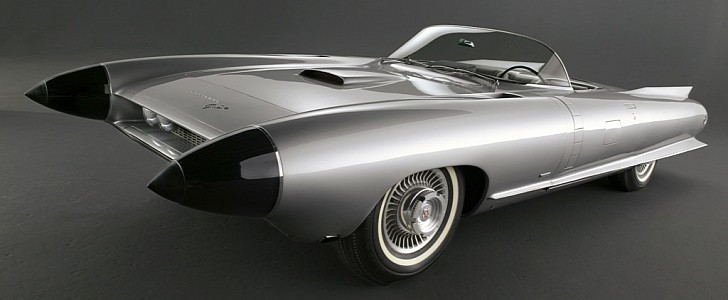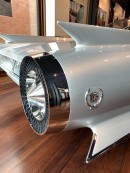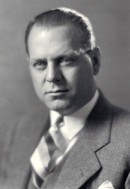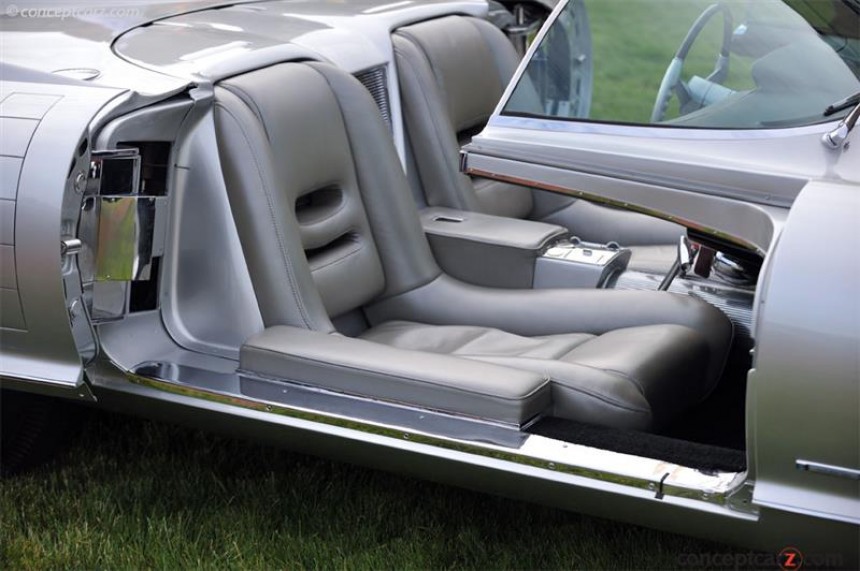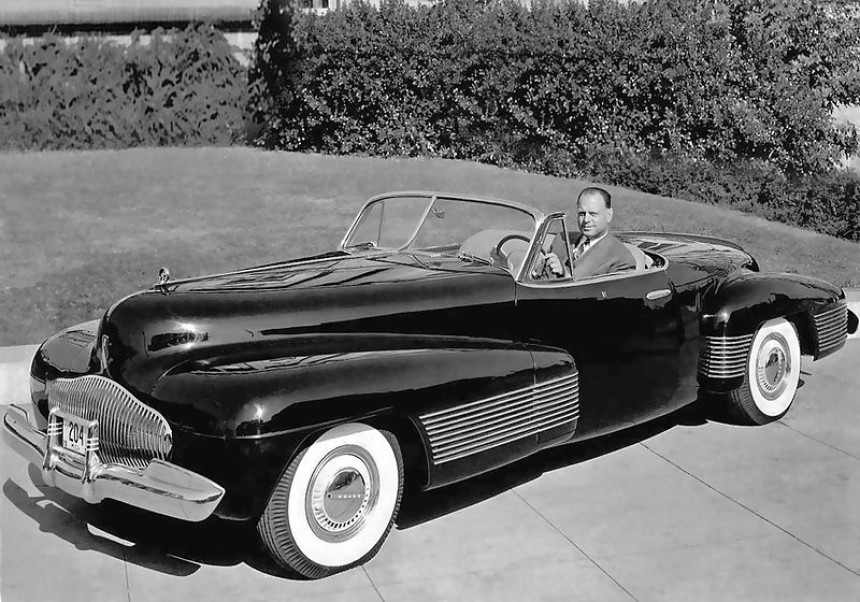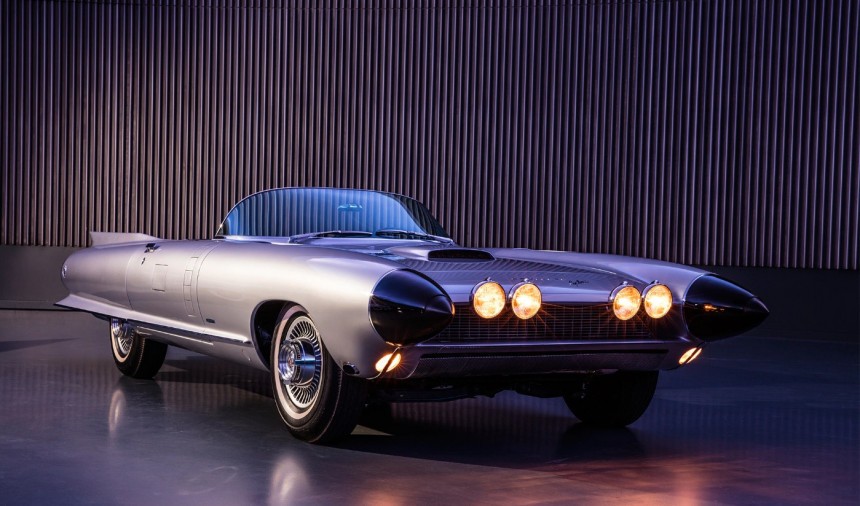The 1959 Cadillac Cyclone was miles beyond the technology and styling of the day, and though it was just a ‘concept,’ it was also a missed opportunity and yet another of Harley Earl’s iconic designs.
The car was a masterpiece of technology and a bold statement of modernity. Between a set of rocket motor-like tubes, a glass bubble over the car’s interior cabin, and obscured only by a thin strip of chrome atop of the windshield, the driver enjoyed almost 360-degrees of view.
Harley Jarvis Earl, the powerful American automotive designer and business executive, was the designated head of design at General Motors and later became a vice president. He was the first executive ever appointed as design chief of a major corporation in American history.
His industrial design background and pioneering work in transportation design specifically made him a force to be reckoned with in the boardroom and on the factory floor. Earl’s experience as a coachbuilder led him to experiment with freeform sketching and hand-sculpted clay models to realize his visions.
But it was Earl’s introduction of the ‘concept car’ as a part of the automotive design process and as a powerful marketing device for buyers intent on expressing their individuality through their autos that cemented his legacy.
Earl's Buick Y-Job is generally recognized as the first concept car, and his "Project Opel" ultimately morphed into what eventually became the Chevrolet Corvette. He was also responsible for the introduction of the ‘tailfin’ as an automotive cue. Earl went on to be a major contributor during World War II to Allied research and development programs in the development of camouflage techniques.
As one of the last cars designed by Earl, the Cyclone functioned as a testbed for futuristic styling and groundbreaking technology. Built with a 104" wheelbase, the Cyclone featured a front-mounted 390cu-in engine, a rear-mounted automatic transaxle, and all-wheel independent suspension. In addition, the Cyclone's exhaust was ported from the engine ahead of the front wheels as another innovation.
But the most startling feature of the car may well have been a radar-operated collision avoidance system which saw the sensors mounted in twin "nose cones" - or Dagmars - at the front of the car.
"Among its advanced engineering features is a radar-locating device, which scans the highway, and warns the driver electronically of objects in its path," says GM's Heritage Center website of the Cyclone. "Large, twin nose cones in the front of the car house the proximity-sensing units. They electronically alert the driver with both an audible signal and a warning light if an object is in its path."
One of the Cyclone's grandest features was a bubble top canopy, and it was silver coated to provide passengers with UV protection. The canopy automatically opened along the same rails which mounted and operated the sliding electrically operated doors. It was also possible to stow the canopy in a rear compartment on a specially designed airbag.
Earl said his Cyclone's design was largely inspired by aviation and rocket designs of the 1950s, and it was marked with the logo of the General Motors Air Transport Section (GMATS).
The Cyclone's doors slid backward in much the same way that the doors of many modern minivans operate today. And because the car had no roll-down windows, GM engineers thoughtfully provided an intercom and speaker system so that occupants could communicate with anyone outside the car.
And shamefully, the car never made it to production though the single most inventive feature of the car is now commonplace on modern vehicles. The Cyclone’s radar system, which was capable of scanning the road ahead and alerting the driver to obstacles in its path, was the precursor to the forward collision warning and automatic emergency braking systems which are becoming standard in today’s top of the line cars, trucks and SUVs.
Harley Jarvis Earl, the powerful American automotive designer and business executive, was the designated head of design at General Motors and later became a vice president. He was the first executive ever appointed as design chief of a major corporation in American history.
His industrial design background and pioneering work in transportation design specifically made him a force to be reckoned with in the boardroom and on the factory floor. Earl’s experience as a coachbuilder led him to experiment with freeform sketching and hand-sculpted clay models to realize his visions.
Earl's Buick Y-Job is generally recognized as the first concept car, and his "Project Opel" ultimately morphed into what eventually became the Chevrolet Corvette. He was also responsible for the introduction of the ‘tailfin’ as an automotive cue. Earl went on to be a major contributor during World War II to Allied research and development programs in the development of camouflage techniques.
As one of the last cars designed by Earl, the Cyclone functioned as a testbed for futuristic styling and groundbreaking technology. Built with a 104" wheelbase, the Cyclone featured a front-mounted 390cu-in engine, a rear-mounted automatic transaxle, and all-wheel independent suspension. In addition, the Cyclone's exhaust was ported from the engine ahead of the front wheels as another innovation.
But the most startling feature of the car may well have been a radar-operated collision avoidance system which saw the sensors mounted in twin "nose cones" - or Dagmars - at the front of the car.
One of the Cyclone's grandest features was a bubble top canopy, and it was silver coated to provide passengers with UV protection. The canopy automatically opened along the same rails which mounted and operated the sliding electrically operated doors. It was also possible to stow the canopy in a rear compartment on a specially designed airbag.
Earl said his Cyclone's design was largely inspired by aviation and rocket designs of the 1950s, and it was marked with the logo of the General Motors Air Transport Section (GMATS).
The Cyclone's doors slid backward in much the same way that the doors of many modern minivans operate today. And because the car had no roll-down windows, GM engineers thoughtfully provided an intercom and speaker system so that occupants could communicate with anyone outside the car.
